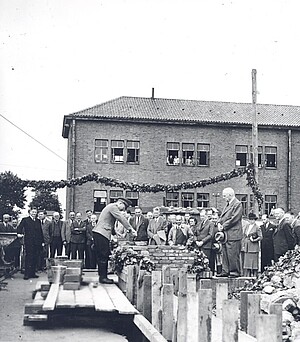
Internment Camp
The last of the prisoners and SS guards left Neuengamme on 2 May 1945. When British troops arrived at the camp shortly after, they found a large area with several barracks. However, there were no traces of what had actually happened there. In June 1945, the British military government began using the former concentration camp as Civil Internment Camp No. 6 for former SS members, civilian officials of the Nazi state and suspected war criminals. The internment camp was closed on 13 August 1948.
Prison
The city of Hamburg took over the grounds of the former concentration camp in 1948 and began using the site as a prison. The wooden prisoners’ barracks were torn down and replaced by a large new building in 1950. Almost all of the brick buildings from when the site was a concentration camp were preserved and used as prison and administration buildings or as workshops. Several of the SS barracks and the commandant’s house served as housing for prison employees. At the end of the 1960s, the judicial authorities built a second prison facility on the former grounds of the concentration camp, where the clay pits had been.
The Memorial
Due to growing pressure from survivors’ associations and after a lengthy public debate, the Senate of the Free and Hanseatic City of Hamburg decided to relocate the prisons in 1989. However, the first prison was not closed until June 2003, the second prison in February 2006. After the demolition of the prisons and the transfer of property ownership in May 2007, the Memorial encompassed almost the entire area of the former concentration camp. Reminders of the site’s post-war use include a remnant of the first prison on the grounds of the former prisoners’ compound and a section of a wall attached to a guard tower from the second prison where the clay pits were once located.
“Neuengamme concentration camp is a weight on Hamburg’s conscience, honour and reputation, much like a curse. The city’s reputation of inhumanity and the terrible horror of this camp must be erased from what will be remembered of our time. We now have the opportunity to achieve this by building a model prison here that restores the reputation of Neuengamme and of Hamburg.”
Application from prison authorities to the Senate of Hamburg (application from 21 October 1947, Hamburg Ministry of Justice)

